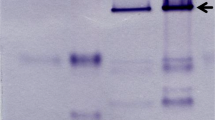Abstract
Besides possessing many physiological roles, nitric oxide (NO) produced by the immune system in infectious diseases has antimicrobial effects. Trichomoniasis, the most widespread non-viral sexually transmitted disease caused by the microaerophilic protist Trichomonas vaginalis, often evolves into a chronic infection, with the parasite able to survive in the microaerobic, NO-enriched vaginal environment. We relate this property to the finding that T. vaginalis degrades NO under anaerobic conditions, as assessed amperometrically. This activity, which is maximal (133 ± 41 nmol NO/108 cells per minute at 20°C) at low NO concentrations (≤ 1.2 μM), was found to be: (i) NADH dependent, (ii) cyanide insensitive and (iii) inhibited by O2. These features are consistent with those of the Escherichia coli A-type flavoprotein (ATF), recently discovered to be endowed with NO reductase activity. Using antibodies against the ATF from E. coli, a protein band was immunodetected in the parasite grown in a standard medium. If confirmed, the expression of an ATF in eukaryotes suggests that the genes coding for ATFs were transferred during evolution from anaerobic Prokarya to pathogenic protists, to increase their fitness for the microaerobic, parasitic life style. Thus the demonstration of an ATF in T. vaginalis would appear relevant to both pathology and evolutionary biology. Interestingly, genomic analysis has recently demonstrated that Giardia intestinalis and other pathogenic protists have genes coding for ATFs.
Similar content being viewed by others
Author information
Authors and Affiliations
Corresponding author
Additional information
Received 1 November 2003; received after revision 5 January 2004; accepted 13 January 2004
Rights and permissions
About this article
Cite this article
Sarti, P., Fiori, P.L., Forte, E. et al. Trichomonas vaginalis degrades nitric oxide and expresses a flavorubredoxin-like protein: a new pathogenic mechanism?. CMLS, Cell. Mol. Life Sci. 61, 618–623 (2004). https://doi.org/10.1007/s00018-003-3413-8
Issue Date:
DOI: https://doi.org/10.1007/s00018-003-3413-8




